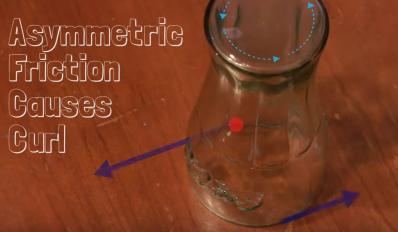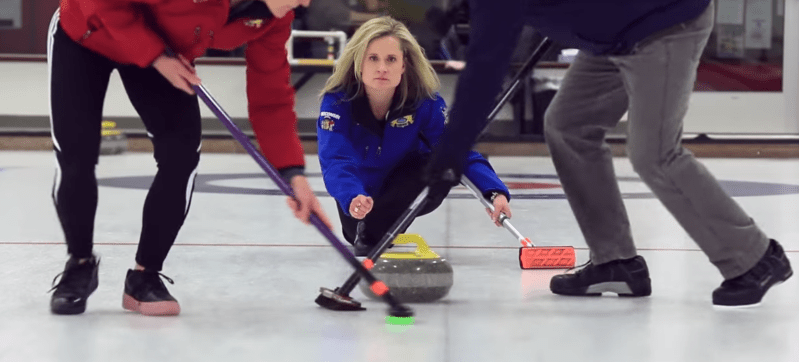It turns out that curling involves some complex physics. [Destin] of Smarter Every Day has jumped in to find out why scientists on opposite sides of the Atlantic disagree about why curling stones curl.
 If you’ve been watching the Olympics, you’ve probably seen some curling, the Scottish sport of competitively pushing stones on ice. As the name implies, curling stones don’t go straight. The thrower pushes them with a bit of rotation, and the stones curve in the direction they are rotating. This is exactly the opposite of what one would expect — try it yourself with an inverted drinking glass on a smooth table. The glass will curl opposite the direction of rotation. Clockwise spin will result in a curl to the left, counterclockwise in a curl to the right.
If you’ve been watching the Olympics, you’ve probably seen some curling, the Scottish sport of competitively pushing stones on ice. As the name implies, curling stones don’t go straight. The thrower pushes them with a bit of rotation, and the stones curve in the direction they are rotating. This is exactly the opposite of what one would expect — try it yourself with an inverted drinking glass on a smooth table. The glass will curl opposite the direction of rotation. Clockwise spin will result in a curl to the left, counterclockwise in a curl to the right.
The cup makes sense when you think about the asymmetrical friction involved. The cup is slowing down, which means more pressure on the leading edge. The rotating leading edge pushes harder against the table and causes the cup to curl opposite the direction of rotation.
The problem is that curling stones don’t do this. Scientists at Uppsala University in Sweden believe it is due to the scratch theory — the leading edge of the stone scratches the ice as it passes, which imparts a force on the trailing edge of the stone.
Dr. Mark Shegelski from Canada’s University of Northern British Columbia disagrees. His theory is that asymmetric friction melting is at play. The stone melts the ice as it passes, creating a thin film of water which the stone rides on.
It could be that both of these theories are correct — and both forces are at play. The hard part is isolating one from the other. Both scientists have done some practical experiments, but not enough to satisfy the scientific community. Can one of our hackers come up with definitive proof as to why curling stones curl the way they do? Let us know down in the comments.
We love stories that still have scientists guessing. A great example is the ball bearing motor, which we featured back in 2014.















Curling is probably the only Olympic sport I could participate in. I could be one of the broom guys.
Now, if they ever combine surfing and skeet shooting, then there would be a second sport I could do.
“Summer biathlon,” I like it.
I like your name for it!
They did this in Top Secret it’s call skeet surfing. You can be forgiven for not having seen the movie. Lots of bad one liners not much movie.
It had some pretty great lines in it, IMHO.
Nick Rivers shows up at the farmhouse: “Is this the potato farm?”
“Yes, I’m Albert Potato”
But wait, there’s more!
http://www.imdb.com/title/tt0088286/quotes
Many people watch curling and get that “I could do that” feeling. Obviously, you don’t need to be in peak physical condition to be an Olympic curler. However, “Easy to learn, difficult to master” applies to curling as it does to many things.
I encourage people to try curling if they get a chance. I had a lot of fun when I did.
You don’t have to be in peak physical condition (relatively) to be an Olympic Pistol Marksman either!
Yet, they just busted a Russian Curling guy for doping! He flunked the drug test and has admitted to it so now, he is out of the Olympics. I have no idea why someone would take enhancing drugs for Curling, It made me laugh when I heard this on the news this a.m.
https://www.nytimes.com/2018/02/19/sports/olympics/olympic-curling-doping-reaction.html
My first thought when I read “Curling team member took performance enhancing drugs” was “Wait!! When did the Olympics declare beer as a PED???”
Alcohol is considered a PED in marksmanship.
I don’t know if it was a fake or not, but I recently saw that Mr. T likes curling.
Curling is cool, fool.
“If everybody had a 12 gauge… and a surfboard too…”
… Then nobody has a surfboard.
YES! Top Secret! That was my thought, too! :-)
https://www.youtube.com/watch?v=7f_19nxNfjs
Well that would definitely need some Top Secret training
Check on youtube something like top 15 curling shots and you will see how agile the sweepers(don’t know the term for the ice heating with broom people) are. Especially when they go for an eye of a needle shot and they must not touch anything on the way there.
“I could be one of the broom guys”
You’d think, but probably not. Being _useful_ and effective at sweeping is quite demanding in strength and balance. You’re putting as much of your weight as you can on the broom which mens you’re taking it off of your feet while hustling down a 50 yard slab of ice. It is anything but rare for someone to fall while sweeping and you could give yourself a hell of a concussion.
It’s also quite a workout when a stone actually needs sweeping. It’s a max effort / HIIT interval. And if you’re the third guy to throw, you could be huffin’ & puffin’ while trying to make your shot…kinda like the biathletes shooting after racing around on XC skis.
In addition…3 of the 4 players on a team will be doing a fair bit of sweeping. All 4 will throw rocks. You can’t just “be a sweeper”.
It may look it on TV, but curling is no joke.
skeet surfing or surfer shooting?
It all started with skipping a rock across a lake… Then the lake froze in winter… So the rock got bigger… and got a handle. Now for the broom… I guess it was to brush all the smaller rocks and twigs out of the way. Or maybe how they reached the poor fellow that broke thru the ice when the stone was too heavy.
I heard (years ago) that in addition to sweeping ice flakes out of the way; the sweeping action of the brooms creates a small vacuum in front of the stone. This allows the brooms handlers the ability to slightly (sleetly? -I jest!) steer the stone.
The sweepers “polish” the ice, which will then be a little bit warmer as well, which helps the stone slide over the ice. Differential sweeping each side of the stone’s path can steer it a bit also.
Isn’t it the the other way around?
Clockwise is right way turning and counterclockwise is turning left.
So clockwise turning leads to a right curve?
Or am I wrong?
So I’ve had a couple of courses on fluid mechanics in my study programme. One of the things i always like in those derivations is to assume that you already have certain behaviour (for instance this counter-curl, or normal curl) and then you try to find out whether the behaviour will die out, be amplified or be inverted.
Now to be honest i think this problem is quite complex, but i might actually have a look into it sometime.
Does it make a difference if they are playing north-south or east-west?
Does it spin the other way in Australia? ;)
No, the Aussie stone handler must spin it the opposite way for it to work.
B^)
What happens with the spinning glass on ice? Does it still spin the same?
You mean it will wget?
I had to Ggggle that…
https://daniel.haxx.se/docs/curl-vs-wget.html
Wget would be dangerous on ice – frostbitw – no SOCKS :(
*frostbite
Why are they baffled? This is just the gyroscopic effect at work, even at these slow rotations. It’s the lack of friction and the massive weight of the stone that allows it to happen
They explain in the video that your standard forces and friction apply to regular objects against a normal non pebbled ice surfaces and they move in a direction you would expect when it’s spun. Curling rocks against pebbled ice however travel in the opposite direction and that’s what they are trying to work out.
Lower the temperature of the stone and ice considerably, to eliminate the pressure and/or friction melting.
OK. But if I put topspin on a tennis ball ( the top rotating forwards along the line of flight, the bottom rotating away from the direction of flight), it *dives* – curves in the direction of the spin. So something is very different with curling!
If there will be an olympic probe involving curling irons, how it would be named?